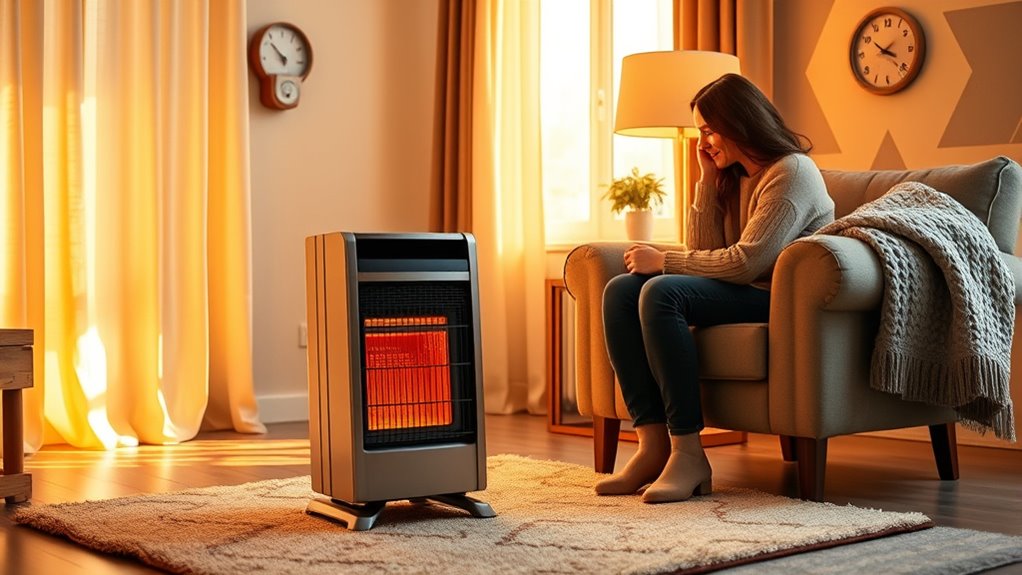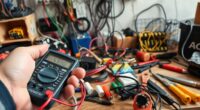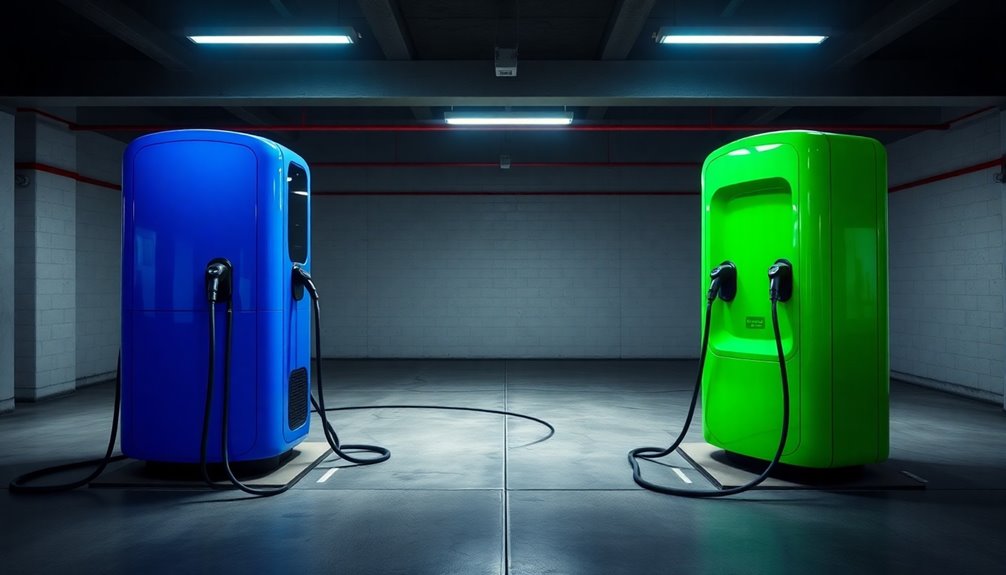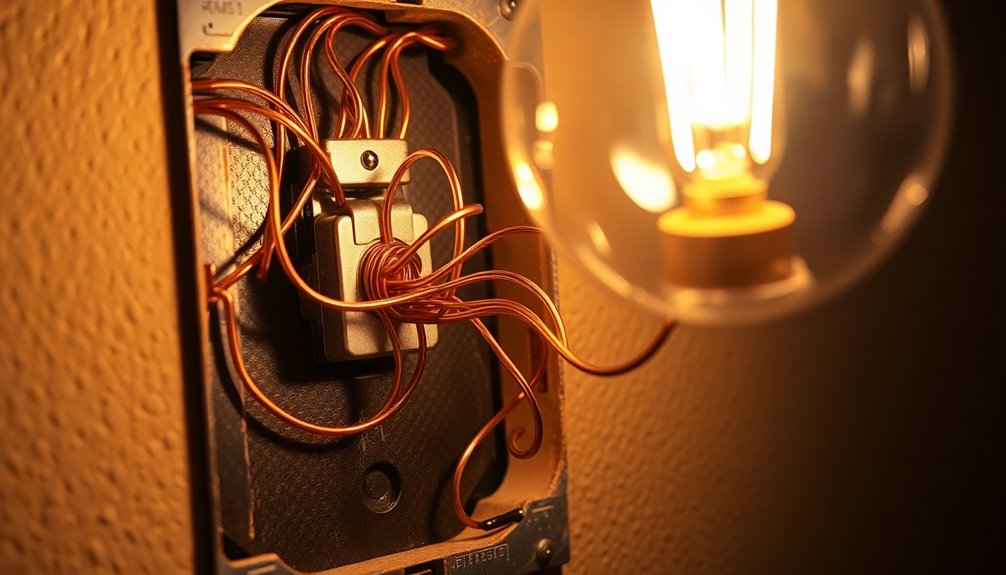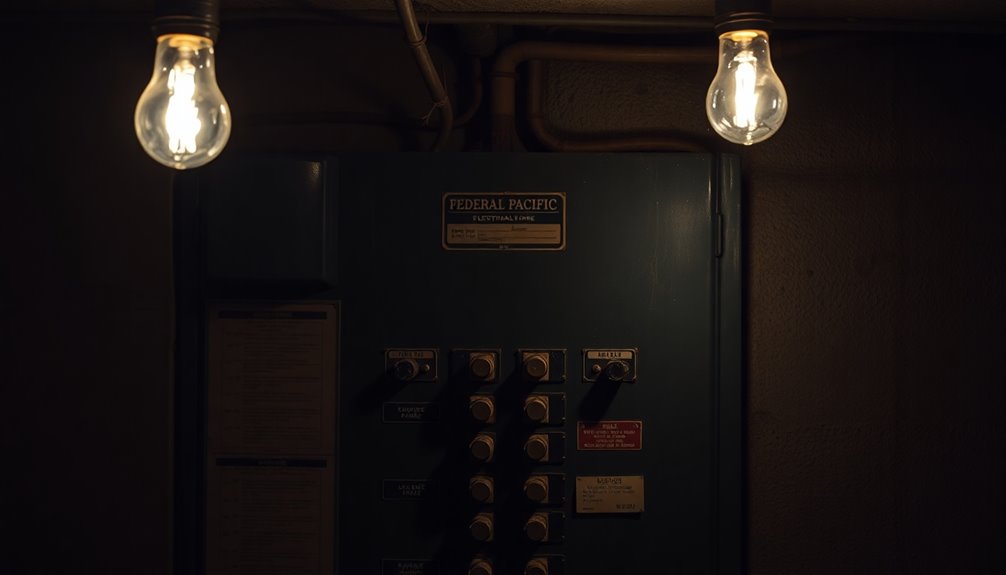To use space heaters safely in winter, choose the right size and type for your space, and place it on a stable, flat surface away from furniture and curtains. Keep combustible materials at least three feet away, never leave the heater unattended when on, and unplug it when not in use. Always supervise children and pets, check for damage, and follow safety guidelines to prevent accidents. If you continue, you’ll get detailed tips to keep everyone safe.
Key Takeaways
- Place heaters on flat, stable surfaces away from water, furniture, and flammable materials, keeping at least three feet distance.
- Never leave space heaters unattended when on, and turn them off before leaving or sleeping.
- Plug heaters directly into wall outlets, avoiding extension cords or multi-plug adapters to prevent overloads.
- Regularly inspect electrical cords, plugs, and outlets for damage, and clean heating elements to ensure safety and efficiency.
- Keep children and pets away from heaters, use safety barriers if available, and install smoke alarms for added protection.
Selecting the Right Space Heater for Your Home
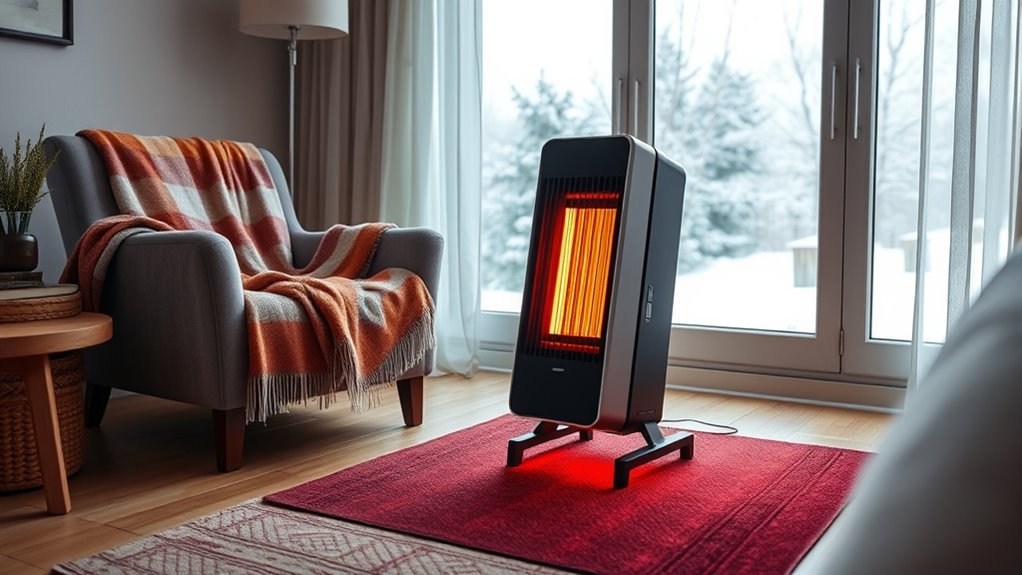
Choosing the right space heater begins with evaluating your specific heating needs and the size of the space you want to warm. First, determine whether you need supplemental heat or primary heating for a room. For small areas like bedrooms or offices, a compact ceramic or oil-filled radiator works well. If you’re heating a larger space, consider a more powerful heater with higher wattage. Pay attention to features like adjustable thermostats, safety shut-off mechanisms, and energy efficiency. Portable units offer flexibility, but ensure they have safety certifications. Also, decide between electric, propane, or kerosene models based on your home’s setup and safety considerations. Selecting an appropriate heater helps keep your space warm, safe, and energy-efficient throughout the winter. Proper heater selection is essential for maintaining safe indoor temperatures and reducing energy consumption.
Proper Placement of Your Space Heater
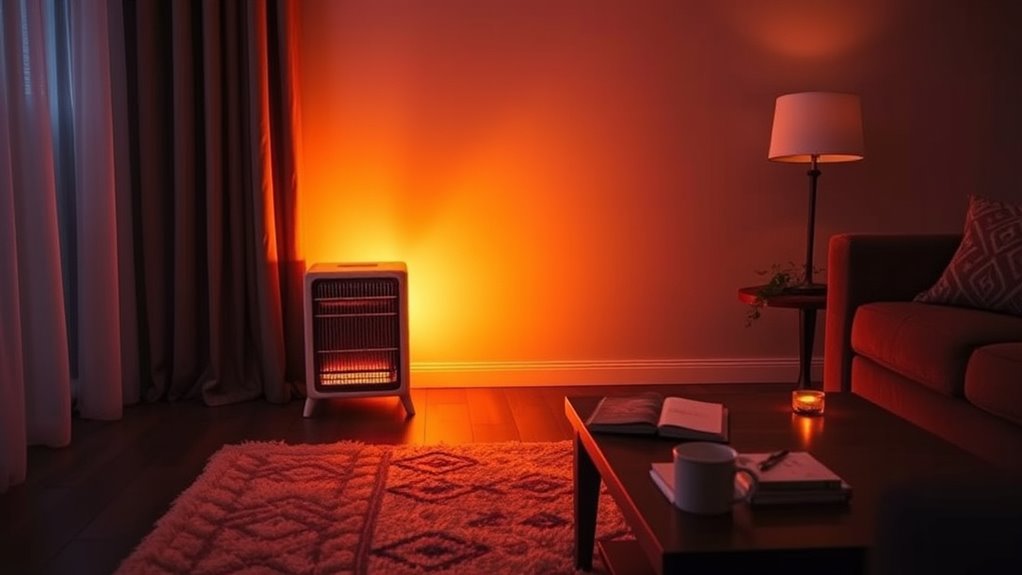
To guarantee safety and maximize efficiency, placing your space heater correctly is essential. Position it on a flat, stable surface away from foot traffic to prevent knocking over. Keep it at least three feet from furniture, curtains, and other objects that could catch fire or obstruct airflow. Avoid placing the heater near water sources like sinks or bathtubs to prevent electrical hazards. Ensure there’s clear space around the heater for proper ventilation and heat circulation. Never place it on uneven or soft surfaces, as this can cause tipping. If your heater has an adjustable thermostat or safety features, set them appropriately before use. Proper placement not only keeps you safe but also helps your heater work more effectively, providing consistent warmth. Additionally, following wood stove safety tips can help prevent accidents and ensure your home remains a cozy and secure environment during winter.
Keeping Combustible Materials Away
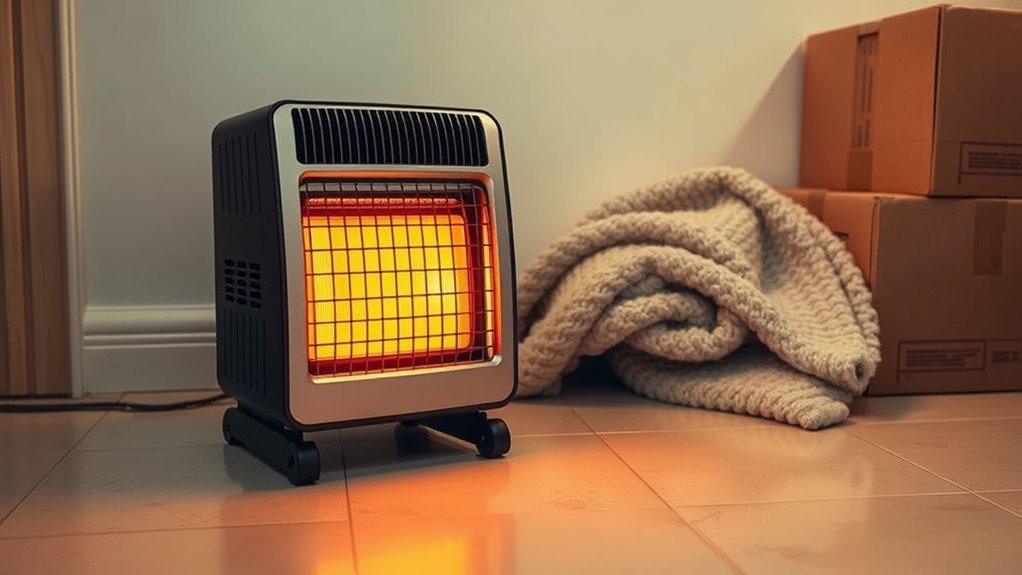
Make sure to clear any flammable items, like paper or fabric, away from your space heater. Keep a safe distance of at least three feet between the heater and combustible materials. Staying vigilant helps prevent fires and keeps your space safe. Additionally, practicing creative problem-solving can help you identify potential hazards and develop effective safety measures.
Clear Flammable Items
Keeping flammable items away from your space heater is essential for preventing fires. You should clear all combustible materials, such as paper, clothing, and curtains, from the heater’s vicinity. These items can ignite quickly if they come into contact with heat or sparks. Make sure nothing is stacked or stored too close to the heater, including furniture or bedding. Keep a safe distance of at least three feet around the unit to reduce fire risk. Regularly inspect the area to ensure no new items have been placed nearby. Remember, even small debris or dust can catch fire if it’s too close to the heater’s heating element. Proper projector placement also helps prevent accidental contact with heat sources. Staying vigilant and maintaining a clear space is key to safe heater use during winter.
Maintain Safe Distance
Maintaining a safe distance between your space heater and combustible materials is essential for preventing fires. Keep anything that can catch fire—such as curtains, paper, furniture, and clothing—at least three feet away from the heater. This gap reduces the risk of heat buildup or accidental ignition. Regularly check that nothing has drifted closer over time. When placing your heater, choose a stable, level surface away from high-traffic areas to prevent knocking it over. Never block air vents or intake areas, as restricted airflow can cause overheating. Remember, even small items left nearby can quickly ignite if they come into direct contact with the heater’s heat source. Adhering to proper equipment safety standards further minimizes fire hazards. Staying vigilant about distance helps keep your home safe during winter.
Regular Maintenance and Inspection

You should regularly inspect your space heater for any signs of damage, like cracks or frayed cords. Make sure to clean the heating elements so they operate efficiently and safely. Also, check all electrical connections to prevent potential fire hazards. Additionally, ensure that your heater’s filter replacement is performed as recommended to maintain optimal performance.
Inspect for Damage Regularly
Regularly inspecting your space heater for damage is essential to guarantee safe operation throughout the winter. Look for cracked or frayed cords, which can cause electrical fires. Check the power switch and plug for damage or looseness, ensuring they function properly. Examine the heater’s housing for signs of burns, cracks, or corrosion. Ensure vents are clear and unobstructed to prevent overheating. If you notice any damage, immediately unplug the heater and avoid using it until repairs are made or a replacement is purchased. Regular inspections help catch problems early, reducing the risk of fire or malfunction. Remember, a well-maintained heater runs more efficiently and keeps your space safe all season long. Ongoing safety monitoring is vital as advancements in AI emphasize the importance of continuous oversight to prevent hazards.
Clean Heating Elements
Since dust and debris can accumulate on heating elements over time, it’s important to clean them regularly to guarantee efficient operation. Dirty elements can cause uneven heating, reduce efficiency, and increase fire risks. To clean your heater’s elements, turn off the unit and unplug it. Use a soft brush or vacuum with a brush attachment to gently remove dust and debris. Avoid using water or liquids, which could cause damage. Regular cleaning helps maintain safe and effective heating. Here’s a quick guide:
| Step | Action | Safety Tip |
|---|---|---|
| 1 | Turn off and unplug | Wait for cool-down period |
| 2 | Gently brush or vacuum | Use gentle pressure |
| 3 | Inspect for damage | Replace if necessary |
Maintaining clean elements keeps your heater running safely and efficiently, especially considering the importance of proper maintenance for safety and performance.
Check Electrical Connections
Keeping electrical connections in good condition is essential for safe heater operation. Faulty or loose connections can cause sparks, shorts, or fires. Regularly inspect your heater’s plugs, cords, and outlets to make certain they’re secure and damage-free. Here are key steps to follow:
- Check for frayed or cracked cords and replace if damaged.
- Ensure plugs fit snugly into outlets without looseness.
- Look for signs of overheating, such as discoloration or melting.
- Tighten any loose connections or replace faulty components immediately.
- Be aware that improper electrical connections can also affect the performance of electric bikes and other motorized equipment.
Using Space Heaters on a Stable, Flat Surface
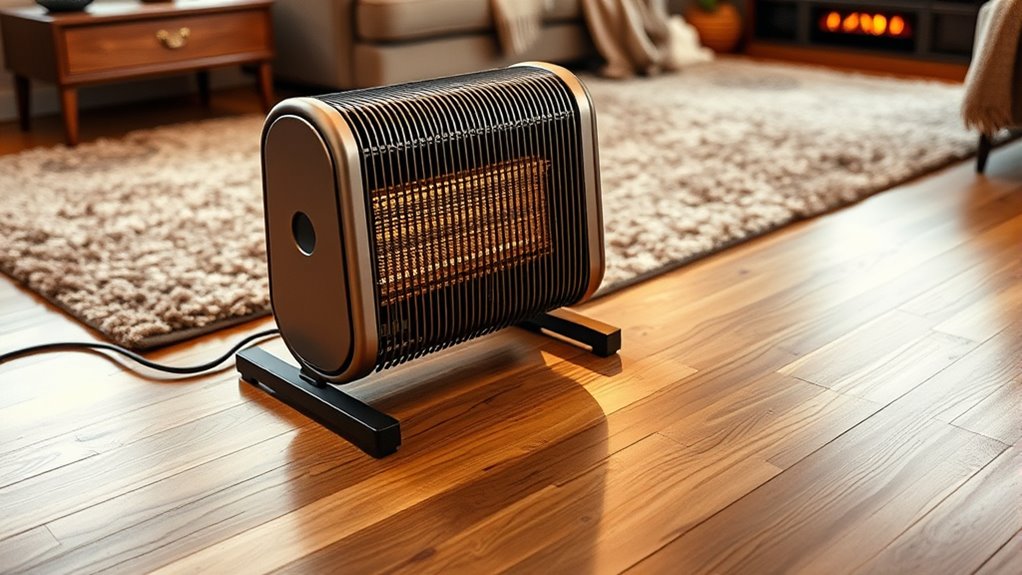
Placing your space heater on a stable, flat surface is essential for safe operation. An uneven or wobbly surface increases the risk of tipping over, which can cause fires or burns. Choose a level area away from furniture, curtains, or other combustibles. Ensure the surface is sturdy enough to support the heater’s weight without shifting. If the heater has rubber feet or non-slip pads, make sure they’re clean and secure. Keep the heater away from clutter to prevent accidental knocking. Never place it on unstable surfaces like tables or stacked objects. A solid, flat surface helps maintain stability and ensures proper airflow. Proper placement also minimizes fire hazards associated with space heaters. By placing your heater correctly, you reduce the risk of accidents and promote safe, effective heating during winter.
Avoiding Overloading Electrical Circuits
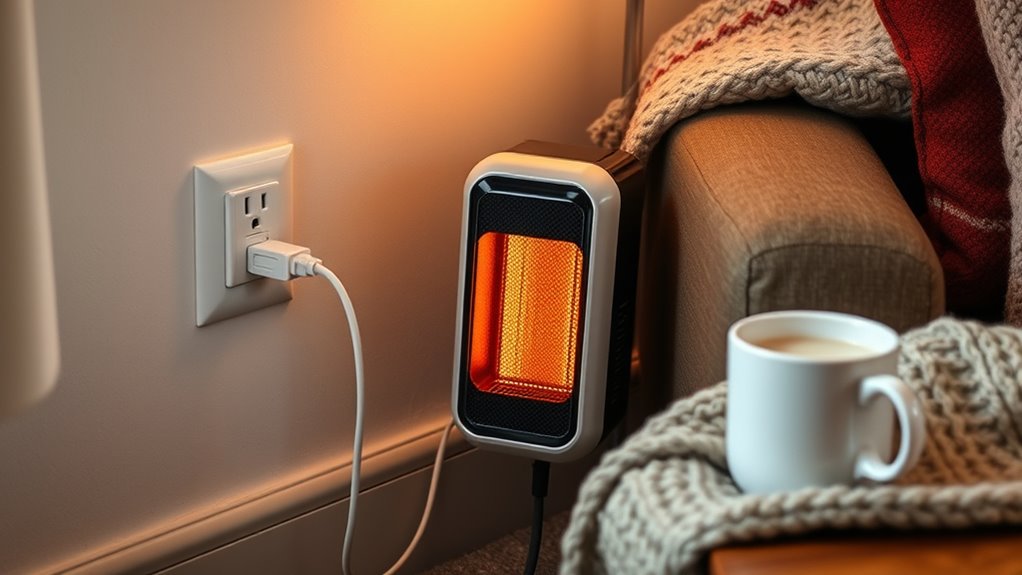
To prevent electrical hazards, you need to avoid overloading your circuits when using space heaters. Overloading can cause overheating, sparks, or fires. To keep things safe:
- Never plug your space heater into an extension cord or power strip; always plug directly into a wall outlet.
- Avoid plugging multiple high-wattage appliances into the same circuit.
- Check your circuit’s capacity—most household circuits handle 15-20 amps—and don’t exceed that limit.
- Be aware of other devices running on the same circuit, like lights or appliances, and limit their use simultaneously.
Supervision and Monitoring During Use
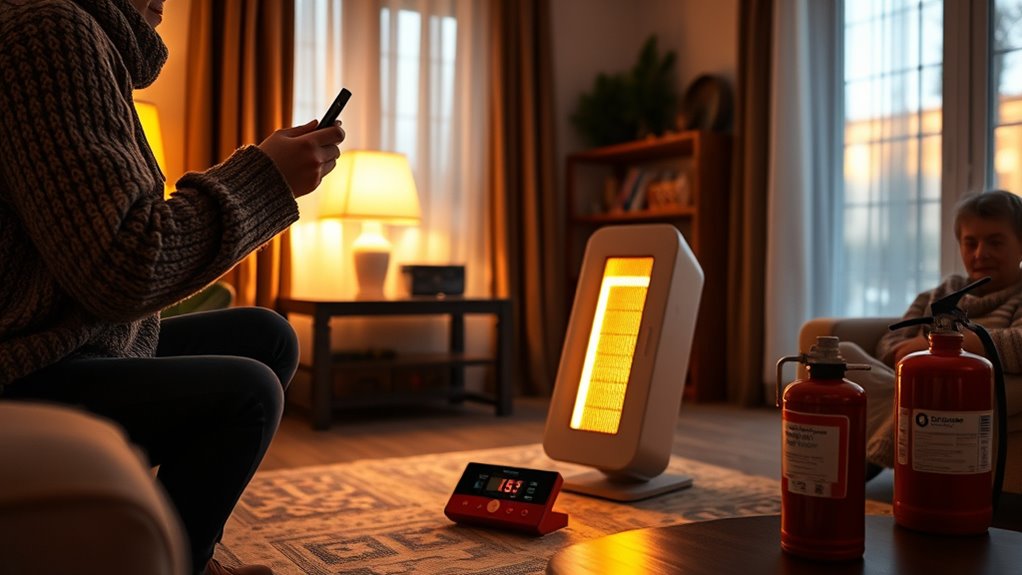
You should never leave your space heater unattended while it’s on, as this heightens the risk of fire. Keep children away to prevent accidents or burns. Constant supervision helps guarantee safe operation and peace of mind.
Never Leave Unattended
Because space heaters can pose serious fire hazards, never leave them unattended while in use. You need to stay alert and monitor the heater continuously to prevent accidents. Here are key points to remember:
- Never leave the heater running when you leave the room or go to sleep.
- Turn off the heater if you’re leaving the house or going to bed.
- Keep an eye on the heater to ensure it’s functioning properly.
- Regularly check for signs of overheating or malfunction during use.
Keep Children Away
Children are naturally curious and may not recognize the dangers of space heaters. That’s why you must keep them away during use. Never leave a space heater unattended when children are nearby. Always supervise your kids and ensure they don’t play around or touch the heater. Use safety barriers or covers if available, and teach children to stay a safe distance. Remind older children about the hazards and establish clear rules about heater safety. Keep heaters out of reach of children when not in use, and unplug them after turning off. This vigilance helps prevent burns, accidental tip-overs, and fires. By actively monitoring children around space heaters, you create a safer environment and reduce the risk of accidents.
Turning Off When Not in Use or Leaving the Room
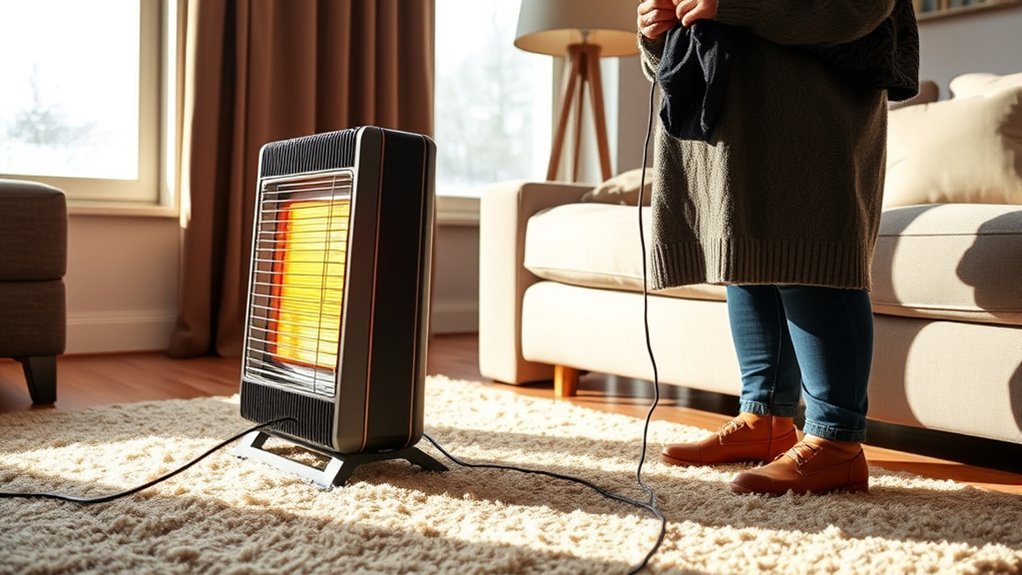
Turning off your space heater when you leave the room or it’s no longer needed is a simple yet effective way to prevent accidents and save energy. Leaving it on unnecessarily can increase fire risks and waste electricity. To guarantee safety and efficiency, follow these tips:
- Always switch off the heater when entering another room.
- Turn it off if you’re leaving the house or going to bed.
- Use timers or automatic shut-off features if available.
- Regularly check that the heater is unplugged when not in use.
Child and Pet Safety Precautions
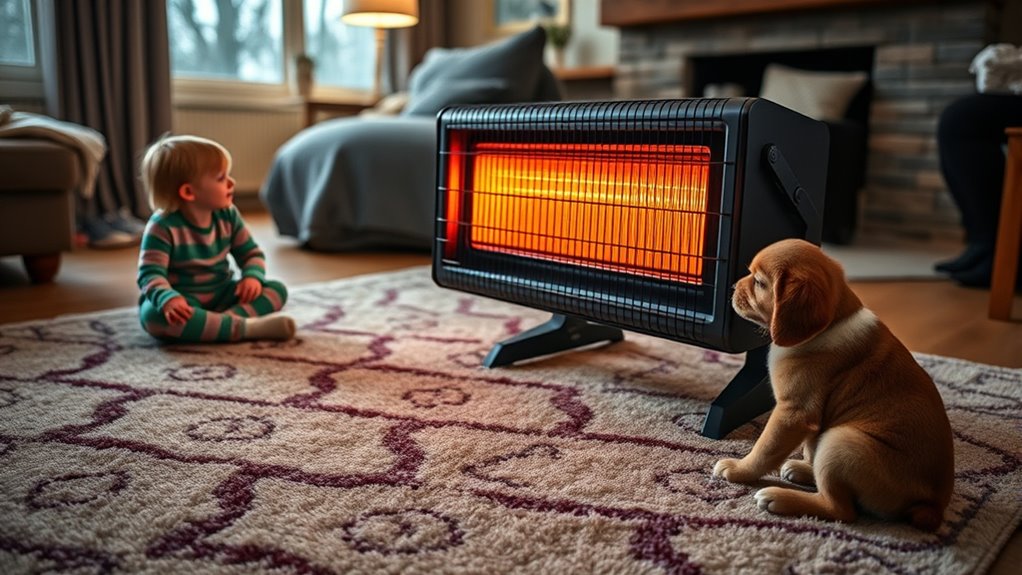
Ensuring your space heater is turned off when not in use helps prevent accidental fires, but extra precautions are needed when kids or pets are around. Keep heaters out of children’s reach by placing them on stable, elevated surfaces away from furniture, curtains, and bedding. Use safety barriers or guards if available, and never leave a child or pet unattended near a heater. Teach kids to stay away from the heater and not to touch it, as surfaces can become very hot. For pets, avoid leaving them alone with the heater running, and ensure cords are secured to prevent chewing. Regularly check for hot surfaces or exposed wiring that could pose risks. Your vigilance helps create a safer environment for everyone in your home.
Emergency Preparedness and Fire Safety Measures
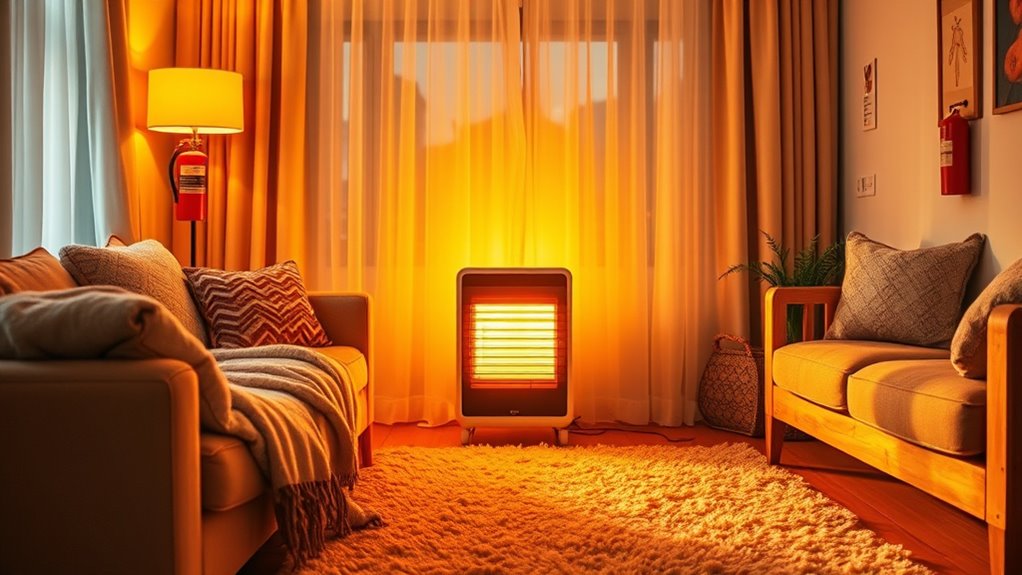
Preparing for emergencies is essential to protect your home and loved ones from fire hazards associated with space heaters. You should have a plan in place and know how to respond quickly. Here are four key safety measures:
- Install smoke alarms on every level and check them monthly.
- Keep a fire extinguisher nearby and know how to use it.
- Create and practice an escape plan with your family.
- Ensure everyone knows how to turn off the heater safely in an emergency.
Additionally, regularly inspect your space heater for damage, and never leave it unattended while in use. Being prepared minimizes risks and helps you respond swiftly if a fire occurs, keeping everyone safe during the winter months.
Frequently Asked Questions
How Can I Prevent Carbon Monoxide Buildup From Space Heaters?
To prevent carbon monoxide buildup from space heaters, you should always use heaters that are vented properly and designed for indoor use. Never operate gas-powered heaters in enclosed spaces without proper ventilation. Keep your space well-ventilated by opening windows or doors slightly, especially if you’re using unvented models. Regularly inspect and maintain your heater to guarantee it’s functioning correctly. Installing a carbon monoxide detector is also a smart safety measure.
Are There Specific Safety Certifications to Look for in Space Heaters?
When choosing a space heater, don’t put all your eggs in one basket—look for safety certifications to guarantee quality. You should check for UL (Underwriters Laboratories) or ETL (Intertek) marks, which mean the heater has met safety standards. These certifications act as a safety net, giving you peace of mind. Always prioritize certified heaters to keep your home safe and warm without surprises.
What Should I Do if My Space Heater Tips Over?
If your space heater tips over, first unplug it immediately to prevent fire hazards. Don’t try to move or reset it until it’s completely cooled down. Check for any damage or exposed cords before restarting. If it won’t stay upright or shows signs of damage, replace it. Always keep a clear area around the heater and use it on a stable, flat surface to prevent tipping over in the future.
How Often Should I Replace or Upgrade My Space Heater?
Imagine your space heater is a vintage car—eventually, it’s time for an upgrade. You should replace or upgrade your heater every 1 to 3 years, especially if it’s showing signs of wear, making strange noises, or failing to heat efficiently. Regularly inspecting it guarantees safety and saves you from unexpected breakdowns. Don’t wait until it’s a dangerous antique—swap it out before it becomes a fire hazard or a costly repair!
Can Space Heaters Be Safely Used Outdoors?
You might wonder if you can safely use space heaters outdoors. Generally, most space heaters are designed for indoor use only, and using them outside can be dangerous due to exposure to moisture and weather conditions. Always check the manufacturer’s instructions; if it’s rated for outdoor use, then it’s safe. Otherwise, avoid outdoor use to prevent electrical hazards, fires, or damage to the heater.
Conclusion
By following these safety tips, you can enjoy the warmth of your space heater without worry. Think of it as tending a gentle flame—careful attention keeps it burning safely. Always select the right heater, place it properly, and stay vigilant. With supervision and regular checks, you create a cozy, secure environment for your home. Keep safety top of mind, and winter warmth will feel comforting, like a soft blanket wrapping you in peace.
